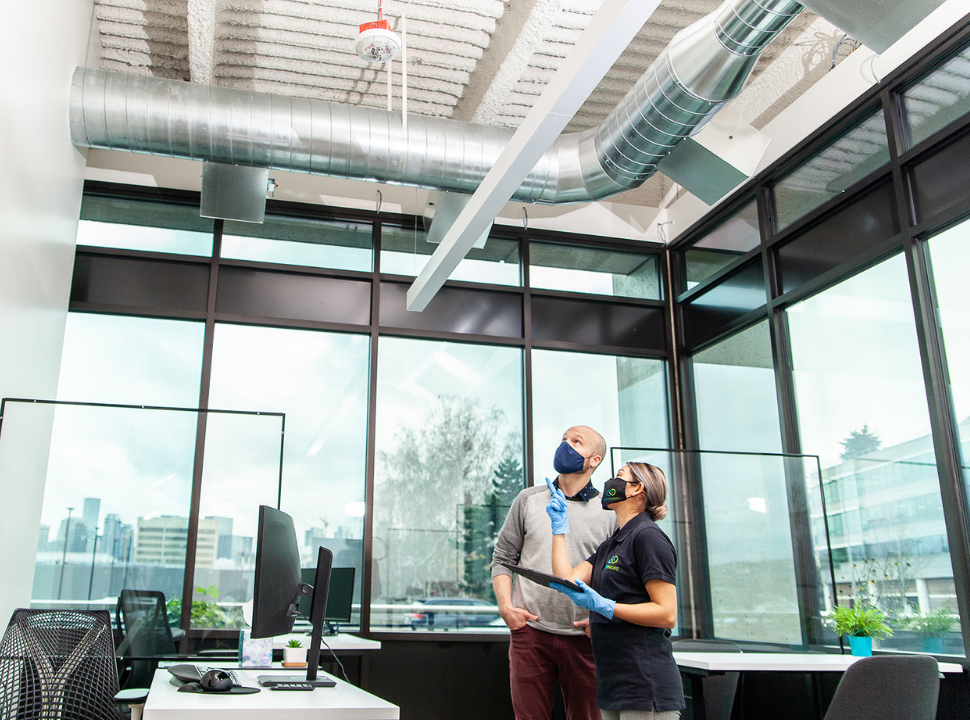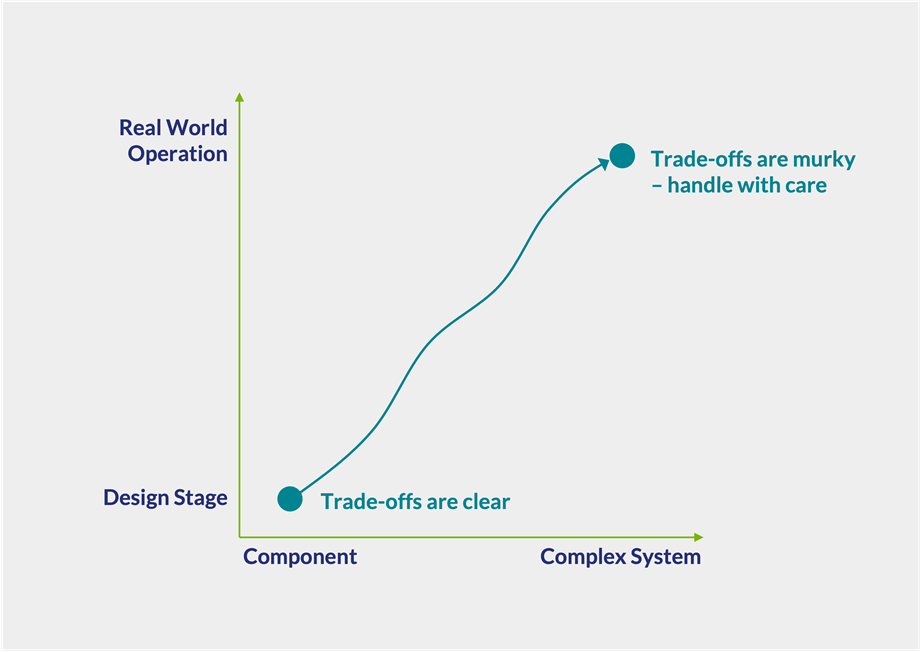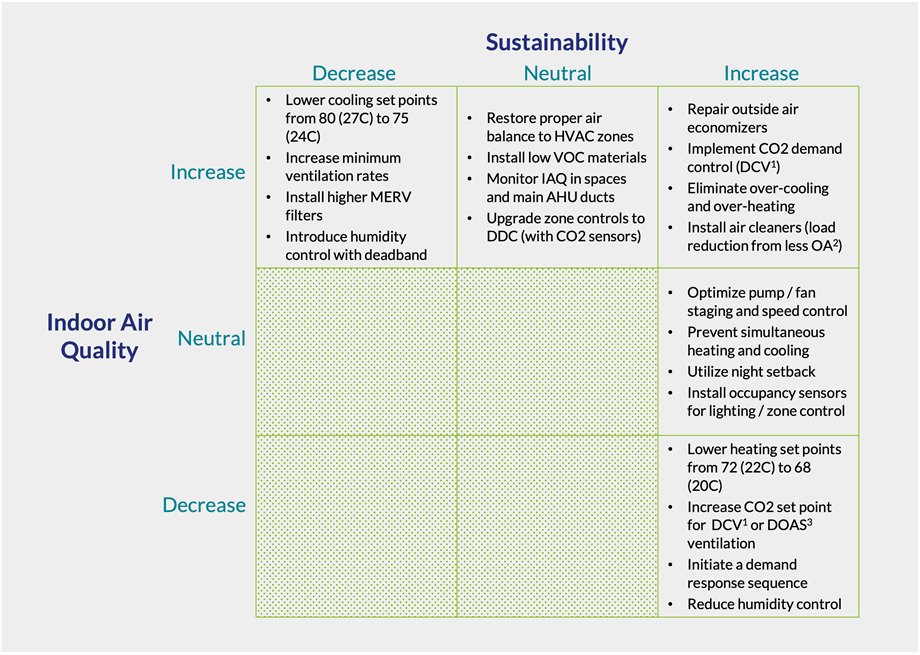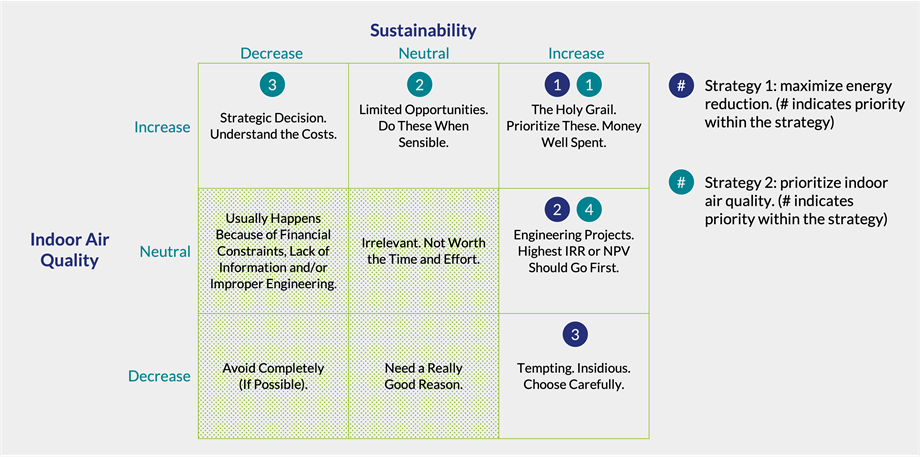The Energy Penalty of Safer Indoor Air
The Energy Penalty of Safer Indoor Air


The COVID-19 pandemic and climate change has placed a heavy burden on HVAC systems to modernize and become energy efficient.
Engineers regularly encounter significant trade-offs in the design and operation of mechanical systems and equipment. In many design situations, not addressing trade-offs means not optimizing the system. However, trade-offs become murkier for engineering under two key conditions as projects move from individual components to a complex and the design stage to real-world operations. Combine these conditions, and trade-offs often become much less evident in aggregate. This nexus of complex systems in the real world is where the HVAC industry usually operates.
The global pandemic has thrust the HVAC discipline of mechanical engineering into upheaval. In 2019, HVAC professionals in commercial, institutional, and public buildings were focused mainly on delivering comfortable temperatures and system performance in a cost-effective, energy-efficient way. That changed in 2020 when the COVID-19 pandemic highlighted the importance of indoor air quality (IAQ).
Ventilation is top of mind, and the guidance of public health officials and academics is taken seriously by engineers. However, in the summer of 2021, another big topic appeared increasingly in the news: disasters from human-caused climate change. Engineers, traditionally laser-focused on reducing energy consumption, are now tasked with making the air in buildings safer while achieving sustainability goals like energy efficiency and reduced carbon emissions.
This is usually framed as a conundrum resulting from a direct trade-off: improved air quality equals increased energy consumption. For certain changes to specific HVAC system components, this is inarguably true. However, we argue that the overall “energy penalty” for making IAQ improvements in practical systems is generally overstated.
Let’s frame the energy penalty in basic terms. Early in the COVID-19 pandemic, in the spring of 2020, ASHRAE recommended that buildings covered by the foundational standard 62.1 Ventilation for Acceptable Indoor Air Quality (most buildings) take three significant actions (among other guidance) to limit the potential for indoor transmission of SARS-COV-2:
Viewed in isolation, each of these actions carries a price tag of increased energy consumption—aside from the potentially significant capital cost to implement these changes. Increased filter efficiency means higher pressure drop across the filter and thus more energy for the motor to turn the fan to push the air harder (see Fan Laws). Increased outside air will undoubtedly result in greater energy consumption by the HVAC system over the course of a year due to the increased heating and cooling loads to condition it (Q=m*C*dT). Similarly, running the system after hours means using more energy.
Recommended for You: HVAC Systems are the Front Line in the Fight Against COVID-19
The energy penalty associated with better IAQ is clear for many small, simple systems in design phases. However, in most practical building situations, the reality is much more complex. Leaving aside the specific ASHRAE guidance, the engineer is faced with a matrix of possible choices regarding IAQ and energy consumption more generally in buildings.
Managers and engineers rarely take one remedial action in isolation. Instead, engineers should view system upgrades as a portfolio of actions and design choices. Engineers who have worked in energy reduction-focused capital programs will understand this concept well. Each decision usually results in a project with an associated capital cost—and there is a fixed amount of CAPEX (read: budget) over a certain time horizon. You get the biggest bang for your buck by prioritizing projects with a strategy. Since energy-conscious mechanical engineers design these IAQ upgrades with a strong sustainability preference in many cases, we encourage them to shift their mindset from “Strategy 1” to “Strategy 2,” as seen in the figure below.
The notion of a struggle between IAQ and sustainability assumes that indoor air is at an acceptable quality in most occupied buildings today. That premise is increasingly challenged, especially considering the very real risks of indoor disease transmission, evidenced by the pandemic. The truth is, we have all expected way too little of the air inside buildings we occupy. Spend a few weeks with an inexpensive IAQ monitor in your home, and you will see how toasters and feather dusters produce particulate matter, that the humidity varies widely, and how carbon dioxide builds up quickly in an enclosed space where people are breathing and talking. The vast majority of engineering effort has gone to controlling temperature alone.
Beyond these environmental variables, which are known to affect health and wellness, the science from public health and engineering academics is obvious: infectious aerosols emitted by people can cause respiratory disease transmission. All of us, including engineers responsible for ventilation design, have come to tolerate an “Acceptable Level of Indoor Air Quality” (from the title of the standard of record in the U.S.) for too long.
A strong argument can be made that health and wellness-targeted improvements in ventilation and IAQ lead, however indirectly, to higher productivity and, thus, people in aggregate doing more with less. What is the point of even constructing and operating buildings, which have huge amounts of embodied carbon, in the first place if they do not serve the people who use them? (See Healthy Buildings, Allen & Macomber, 2020 Harvard, for more.)
We suggest three practical approaches for engineers addressing these trade-offs.
You May Also Like: HVAC the Virus Killer
Better information leads to better decisions, and new types of indoor air safety testing are now available. Using DNA tracers in an aerosol-based solution, such as veriDART® by SafeTraces, effectively simulates the chemical composition of respiratory aerosols and their movement and can test the effectiveness of ventilation and filtration on removing potentially pathogenic aerosols from indoor spaces. Instead of making decisions and prioritizing investments based on changing, broad-brush guidelines or theoretical information, veriDART enables engineers to verify the effectiveness of key measures to improve IAQ.
With this information, it’s possible to target remediation efforts and make informed decisions on investments to improve occupant health and safety while also minimizing energy consumption. Be smart when implementing recommendations. How much does it improve health and safety to increase outside air percentage by a certain increment? How long should the ventilation be operated after hours to flush the building? Data from veriDART can help answer these questions. Complementary to tracer-based verification testing are ventilation and air quality data collected by digital control systems and sensors, common now in most buildings. Collecting, organizing, and leveraging this data to make decisions is a crucial success factor for optimizing energy and IAQ performance and is the cornerstone of most “smart building” programs.
The main reason for overstating the sustainability-IAQ trade-off is that most operating HVAC systems are not optimized and have a deferred maintenance backlog. Regular maintenance and repair of HVAC systems are critical to ensuring good IAQ and helps optimize energy efficiency. But many issues go undiagnosed in large, complex systems. Building analytics software, called Fault Detection & Diagnostics (“FDD”), helps proactively identify problem areas and address them to optimize ventilation performance and energy efficiency. One leading FDD solution provider recently analyzed data from their cloud-based solution to find that, in July 2021, across 2,200 buildings in 30 countries, roughly 10 percent of zone equipment and 20 percent of air handling units had at least one mechanical or controls issue affecting IAQ.
In addition, from June 2020 to July 2021, across 400 million square feet of buildings, there had been over 1,700 IAQ-improving failures identified and resolved, resulting in an aggregate estimated annual recurring energy cost savings of about USD $1,000,000. Smart operations and maintenance aided by clever data use can often completely offset the energy penalty of improving IAQ in operating buildings.
Engineers must focus on operations, not idealized designs, to identify optimizations. For example, upgrading air filters is a recommended approach to improve IAQ and reduce infectious aerosols. But it comes with a seemingly clear energy penalty. Which air filters should you use? They are not all equal. One design choice is to use higher-quality filters. In a published case study, moving from low to high-quality air filters (of the same efficiency rating) reduced energy consumption by almost 15 percent and reduced the number of required filter changes from four to two per year. While the filters themselves cost about twice as much, the lower energy cost and fewer change-outs resulted in almost 12 percent less overall cost per year, as well as reductions in carbon emissions and solid waste. This helps significantly offset the energy penalty by increasing the filter efficiency. Engineers should use remedial upgrade projects as an opportunity to make informed changes to systems, equipment, and operations that improve IAQ and optimize sustainability.
Explore Our Energy Blog: Our Energy and Climate Policies are Counterproductive
While engineers face a challenging task balancing sustainability and IAQ, especially in existing facilities with high sunk costs, we believe the challenge will ultimately be a defining moment for the next generation of mechanical engineers working with built environments. Incorporating data from leading technologies like SafeTraces’ veriDART, thinking through strategic portfolios of projects, and understanding the operational realities of the systems they design and build will be key to their success in overcoming the trade-off of sustainability and IAQ.
Erik Malmstrom is the CEO of SafeTraces, a Bay Area technology company and provider of DNA-enabled diagnostic solutions for indoor air quality.
Aaron Lapsley, P.E., is the principal and founder of System2 Consulting, a consulting and engineering firm specializing in technology for the built environment and high-performance building systems.
The global pandemic has thrust the HVAC discipline of mechanical engineering into upheaval. In 2019, HVAC professionals in commercial, institutional, and public buildings were focused mainly on delivering comfortable temperatures and system performance in a cost-effective, energy-efficient way. That changed in 2020 when the COVID-19 pandemic highlighted the importance of indoor air quality (IAQ).
Ventilation is top of mind, and the guidance of public health officials and academics is taken seriously by engineers. However, in the summer of 2021, another big topic appeared increasingly in the news: disasters from human-caused climate change. Engineers, traditionally laser-focused on reducing energy consumption, are now tasked with making the air in buildings safer while achieving sustainability goals like energy efficiency and reduced carbon emissions.
This is usually framed as a conundrum resulting from a direct trade-off: improved air quality equals increased energy consumption. For certain changes to specific HVAC system components, this is inarguably true. However, we argue that the overall “energy penalty” for making IAQ improvements in practical systems is generally overstated.
Let’s frame the energy penalty in basic terms. Early in the COVID-19 pandemic, in the spring of 2020, ASHRAE recommended that buildings covered by the foundational standard 62.1 Ventilation for Acceptable Indoor Air Quality (most buildings) take three significant actions (among other guidance) to limit the potential for indoor transmission of SARS-COV-2:
- Increase filtration efficiency in air handling units (AHUs), which contain fans to move the air and coils to cool/heat it.
- Increase the fraction of outside (“fresh”) air in the air stream supplied continuously to occupied spaces, thus reducing the fraction of air that is recirculated (outside air flow rate + recirculated air flow rate = total supply air flow rate).
- Operate HVAC systems for extended hours to filter/flush occupied spaces of potentially pathogenic aerosols at the end of the day and/or prior to occupancy in the morning.
Viewed in isolation, each of these actions carries a price tag of increased energy consumption—aside from the potentially significant capital cost to implement these changes. Increased filter efficiency means higher pressure drop across the filter and thus more energy for the motor to turn the fan to push the air harder (see Fan Laws). Increased outside air will undoubtedly result in greater energy consumption by the HVAC system over the course of a year due to the increased heating and cooling loads to condition it (Q=m*C*dT). Similarly, running the system after hours means using more energy.
Recommended for You: HVAC Systems are the Front Line in the Fight Against COVID-19
The energy penalty associated with better IAQ is clear for many small, simple systems in design phases. However, in most practical building situations, the reality is much more complex. Leaving aside the specific ASHRAE guidance, the engineer is faced with a matrix of possible choices regarding IAQ and energy consumption more generally in buildings.
Managers and engineers rarely take one remedial action in isolation. Instead, engineers should view system upgrades as a portfolio of actions and design choices. Engineers who have worked in energy reduction-focused capital programs will understand this concept well. Each decision usually results in a project with an associated capital cost—and there is a fixed amount of CAPEX (read: budget) over a certain time horizon. You get the biggest bang for your buck by prioritizing projects with a strategy. Since energy-conscious mechanical engineers design these IAQ upgrades with a strong sustainability preference in many cases, we encourage them to shift their mindset from “Strategy 1” to “Strategy 2,” as seen in the figure below.
The notion of a struggle between IAQ and sustainability assumes that indoor air is at an acceptable quality in most occupied buildings today. That premise is increasingly challenged, especially considering the very real risks of indoor disease transmission, evidenced by the pandemic. The truth is, we have all expected way too little of the air inside buildings we occupy. Spend a few weeks with an inexpensive IAQ monitor in your home, and you will see how toasters and feather dusters produce particulate matter, that the humidity varies widely, and how carbon dioxide builds up quickly in an enclosed space where people are breathing and talking. The vast majority of engineering effort has gone to controlling temperature alone.
Beyond these environmental variables, which are known to affect health and wellness, the science from public health and engineering academics is obvious: infectious aerosols emitted by people can cause respiratory disease transmission. All of us, including engineers responsible for ventilation design, have come to tolerate an “Acceptable Level of Indoor Air Quality” (from the title of the standard of record in the U.S.) for too long.
A strong argument can be made that health and wellness-targeted improvements in ventilation and IAQ lead, however indirectly, to higher productivity and, thus, people in aggregate doing more with less. What is the point of even constructing and operating buildings, which have huge amounts of embodied carbon, in the first place if they do not serve the people who use them? (See Healthy Buildings, Allen & Macomber, 2020 Harvard, for more.)
We suggest three practical approaches for engineers addressing these trade-offs.
You May Also Like: HVAC the Virus Killer
Collect and Utilize as Much Data as Possible
Better information leads to better decisions, and new types of indoor air safety testing are now available. Using DNA tracers in an aerosol-based solution, such as veriDART® by SafeTraces, effectively simulates the chemical composition of respiratory aerosols and their movement and can test the effectiveness of ventilation and filtration on removing potentially pathogenic aerosols from indoor spaces. Instead of making decisions and prioritizing investments based on changing, broad-brush guidelines or theoretical information, veriDART enables engineers to verify the effectiveness of key measures to improve IAQ.
With this information, it’s possible to target remediation efforts and make informed decisions on investments to improve occupant health and safety while also minimizing energy consumption. Be smart when implementing recommendations. How much does it improve health and safety to increase outside air percentage by a certain increment? How long should the ventilation be operated after hours to flush the building? Data from veriDART can help answer these questions. Complementary to tracer-based verification testing are ventilation and air quality data collected by digital control systems and sensors, common now in most buildings. Collecting, organizing, and leveraging this data to make decisions is a crucial success factor for optimizing energy and IAQ performance and is the cornerstone of most “smart building” programs.
Maintain and Monitor Mechanical Systems
The main reason for overstating the sustainability-IAQ trade-off is that most operating HVAC systems are not optimized and have a deferred maintenance backlog. Regular maintenance and repair of HVAC systems are critical to ensuring good IAQ and helps optimize energy efficiency. But many issues go undiagnosed in large, complex systems. Building analytics software, called Fault Detection & Diagnostics (“FDD”), helps proactively identify problem areas and address them to optimize ventilation performance and energy efficiency. One leading FDD solution provider recently analyzed data from their cloud-based solution to find that, in July 2021, across 2,200 buildings in 30 countries, roughly 10 percent of zone equipment and 20 percent of air handling units had at least one mechanical or controls issue affecting IAQ.
In addition, from June 2020 to July 2021, across 400 million square feet of buildings, there had been over 1,700 IAQ-improving failures identified and resolved, resulting in an aggregate estimated annual recurring energy cost savings of about USD $1,000,000. Smart operations and maintenance aided by clever data use can often completely offset the energy penalty of improving IAQ in operating buildings.
Understand and Work with Operational Realities
Engineers must focus on operations, not idealized designs, to identify optimizations. For example, upgrading air filters is a recommended approach to improve IAQ and reduce infectious aerosols. But it comes with a seemingly clear energy penalty. Which air filters should you use? They are not all equal. One design choice is to use higher-quality filters. In a published case study, moving from low to high-quality air filters (of the same efficiency rating) reduced energy consumption by almost 15 percent and reduced the number of required filter changes from four to two per year. While the filters themselves cost about twice as much, the lower energy cost and fewer change-outs resulted in almost 12 percent less overall cost per year, as well as reductions in carbon emissions and solid waste. This helps significantly offset the energy penalty by increasing the filter efficiency. Engineers should use remedial upgrade projects as an opportunity to make informed changes to systems, equipment, and operations that improve IAQ and optimize sustainability.
Explore Our Energy Blog: Our Energy and Climate Policies are Counterproductive
While engineers face a challenging task balancing sustainability and IAQ, especially in existing facilities with high sunk costs, we believe the challenge will ultimately be a defining moment for the next generation of mechanical engineers working with built environments. Incorporating data from leading technologies like SafeTraces’ veriDART, thinking through strategic portfolios of projects, and understanding the operational realities of the systems they design and build will be key to their success in overcoming the trade-off of sustainability and IAQ.
Erik Malmstrom is the CEO of SafeTraces, a Bay Area technology company and provider of DNA-enabled diagnostic solutions for indoor air quality.
Aaron Lapsley, P.E., is the principal and founder of System2 Consulting, a consulting and engineering firm specializing in technology for the built environment and high-performance building systems.









